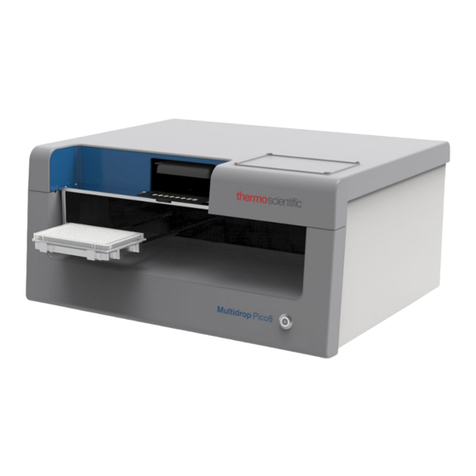
Contents
8Thermo Scientific Multidrop Combi nL User Manual Thermo Fisher Scientific
Using FILLit PC software ...............................................................34
Using internal software....................................................................34
Dispensing parameters ....................................................................34
Plate type .....................................................................................34
Dispensing volume and liquid...................................................... 36
Column/Row selection.................................................................37
Full plate...................................................................................37
Column selection ......................................................................38
Setting the column volume .......................................................38
Row selection............................................................................40
Setting the row volume .............................................................40
Selecting columns and rows (Selected wells)..............................41
Protocol settings.............................................................................. 42
Dispensing speed..........................................................................43
Shaking ........................................................................................ 44
Dispensing offsets.........................................................................45
Height.......................................................................................46
X/Y offset.................................................................................. 47
Predispensing volume................................................................... 47
Dispensing direction .................................................................... 48
Running a protocol .........................................................................50
Save and edit protocol..................................................................51
Select protocol..............................................................................54
Delete protocol ............................................................................54
Instrument options..........................................................................56
Device information ......................................................................56
Computer interface ......................................................................57
Startup protocol ...........................................................................58
Instrument settings.......................................................................59
Calibration................................................................................... 60
Liquid factor (standalone calibration)........................................ 60
Accuracy check..........................................................................61
Factor calculation...................................................................... 63
Screen saver..................................................................................... 65
Shutdown........................................................................................65
Emergency situations ......................................................................66
Maintenance .................................................................................................67
Maintenance checklist..................................................................... 67
Regular and preventive maintenance ...............................................68
How to clean the tubings .............................................................69
Daily maintenance ....................................................................69
Removing foreign particles........................................................69
Disinfecting the liquid path.......................................................72
Routine maintenance of the dispensing valves (tips).....................72
Daily maintenance ....................................................................72
Tip washing ..............................................................................73
Emptying ..................................................................................73
Periodic maintenance ................................................................73




























